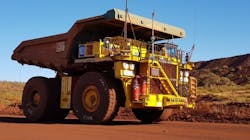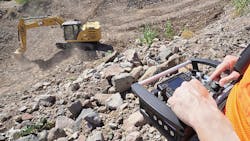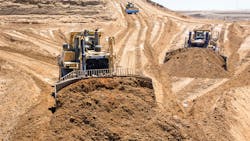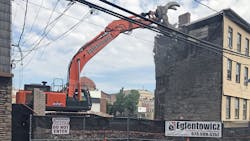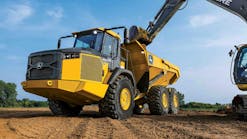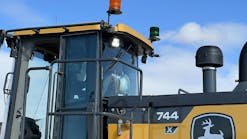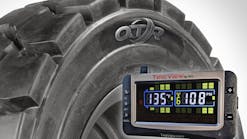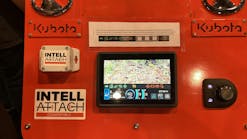By now most everyone has seen publicity about autonomous machinery working at mines around the world, but remote-control technology on a smaller scale can have a home much closer to home—it is available for many applications and can even help managers with employment issues.
The portability of line-of-sight solutions even allows operators to keep remote-control handsets with them in the cab, enabling them to exit the machine and operate it from afar when it approaches a hazardous area.
Read also: CES Now Familiar Territory for Iron OEMs
“They’re usually performing something that’s pretty quick, so they’ll have the console with them in the cab, they jump out of the machine, perform that dangerous work using that line-of-sight remote, and then get back in their cab and run the machine manually,” says Allan Plumkin, autonomy & automation specialist for Caterpillar.
“It’s a flip of the switch. It’s very intuitive and very easy to keep that operator safe during that dangerous application,” Plumkin says. “We are the only manufacturer offering line-of-sight and non-line-of-sight solutions.”
Line-of-sight systems
The Cat Command Console is the line-of-sight (LOS) solution for an operator to control a single machine. An operator can run a crawler dozer, wheel loader, excavator, or compactor from up to 1,300 feet away.
Operators can watch the machine and any attachments with their own eyes.
“It’s an over-the-shoulder console… all the features available in that machine are available on the remote-control console,” Plumkin says. That includes items like grade control and E-fencing.
Read also: Onboard Cameras Elevate Job Site Safety
Not only does LOS remote control keep operators away from site hazards such as crumbling walls and collapsing roofs, but it also helps keep them out of dust clouds and away from potentially hazardous building materials and debris. Also, because it’s lightweight and portable, the over-the-shoulder console lets operators position themselves upwind.
Cat says its Command console provides a relatively affordable way to get started in the world of remote control without the need for a site communications infrastructure.
Non-line of sight systems
NLOS systems (Cat calls theirs Cat Command Station) let the operator work from miles away in a “virtual cab” environment. The simulated cab includes a range of video feeds, a comfortable seat, and full complement of realistic-feeling hand and foot controls.
“We’re using high-definition cameras, mounted on machines, to bring back that feed to an operator that is seated with the machine controls,” Plumkin says. “So, the operator is off the machine in a nice seated, quiet environment operating the machine. Non-line-of-sight is way more versatile in the respect that we can be local to the machine or in a different state. The distance really is only limited by the connectivity.
Read also: Challenges in Safe Fleet Operation, Maintenance Lead to Opportunity for Automation
“As long as they meet the specifications laid out in our technical documents, there is no limitation on distance,” Plumkin says. “That operator in that Command Station is in a seated position, nice ergonomics, and it’s usually a climate-controlled environment with no exposure to the dust and vibration that you’d see on a job site. It’s a more productive, less fatigued environment.”
The benefits of an NLOS system expand on all the safety aspects of a portable LOS system.
[“A] popular application we’re seeing is digging out and remediating ash ponds,” Plumkin says. “Ash ponds are the result of burning coal, and it is a very dangerous application. Most of the machines that break through the ground and have accidents are often fatalities because the ground is unstable. A lot of these companies are mandating remote control. In the past, customers have talked about the sacrifice of productivity for safety… and now you can really have both.”
Of course, technology costs money and an NLOS system will be more expensive than an LOS system, but it can also save money.
A non-line-of-sight application in a video from Teleo. The company's proprietary remote-control autonomous system is brand-agnostic and may be retrofitted to different types of equipment.
“[Operators] can also switch to a different machine or even a different job site instantly, with no downtime,” Plumkin says. “And because no one is in the cab, an idle machine can be shut down to save fuel. There’s no need to run the engine to keep the cab at a comfortable temperature.”
Plumkin tells the story of a contractor that was running three D8 crawler dozers and experimented with remote-control technology. “They actually realized that with Command, with the added productivity, they can get the same work out of two D8s,” Plumkin says.
“Think about the lunch, the day in the life of an operator, the transition of the preshift meetings, the time it takes to walk to the machine, and the breaks,” he says. “Operators can hot swap; so they found out they could be running the machine a lot more, so much so that they can be doing the same amount of work with two dozers now. Eventually, they were able to re-allocate a third of their workforce to support other operations that needed those skilled operators.”
Perhaps the most obvious benefit is to demolition operations. OSHA reports that at least 100 demolition workers lost their lives over the past five years. There can be unstable walls and surfaces, drop-offs, crumbling walls, and choking dust. Remote technology allows the operators to be completely offsite, or, using LOS technology, they can position themselves in a boom lift or scissor lift for a better view and see exactly what the equipment is doing.
Other applications include construction in holes and large trenches into which a machine would have to be manually raised and lowered, narrow sites at precarious elevations, and coal barges.
Addressing workforce issues
Managers may also be able to solve workforce problems using remote-control technology.
“Whether it’s a pipeline job or a quarry in a remote location, customers struggle with getting those qualified operators who have to often travel long distances, so you can imagine being able to now offer a remote location near a highly populated area,” Plumkin says. “Now these operators don’t have to travel an hour or two to the remote location.
“And now that you’re in that office environment, you can take a person in a wheelchair and bring them right up to that station and they can perform work they’d normally be excluded from,” Plumkin says.
For the latest generation of workers, there’s the gamification aspect of remote operation with controls, a console, and, depending on the distance, video feeds.
“There’s an appeal for these younger generations, ‘I’m going to be operating a machine that’s remotely operated and I get paid to do it,’” Plumkin says. In addition, training can be had from more experienced operators, as they can sit right next to the less experienced operator offering instant feedback.
Other major OEMs are in the remote-control arena, too, including Komatsu, Volvo, and Bobcat. Aftermarket solutions for retrofit are an option as well, from companies like Built Robotics, Trimble, and Teleo.
Teleo recently retrofitted iron for three fleets around the U.S.
One of them was Tomahawk Construction, a Florida-based excavation and site development company. It is deploying Teleo technology on 12 articulated dump trucks for land development of residential subdivisions, a retirement community, and commercial businesses.
“We have had two trucks sitting around for months without operators in them,” said Scott Lyons, managing member, Tomahawk Construction, in a statement. “With Teleo, more people will be attracted to this job because they can run trucks from our office and save hours of drive time to and from job sites. Due to the current labor market, we know going forward we need to do more with less. I believe the Teleo system is the vehicle to make that happen.”
“We founded Teleo to help contractors supercharge their operators’ efforts by turning their equipment into semi-autonomous machines,” said Vinay Shet, Teleo co-founder and CEO, in a statement. “By moving the operator out of the cab of the machine and into a command center, we’re also making the operator’s role safer, comfortable, and more accessible.”
What happens if there's an emergency with remote-control equipment? Check out this video from Caterpillar.
